Blog Layout
The History (And Future) of Laser Dentistry
Cherrywood Dental • Jan 28, 2014
Laser dentistry is still developing, but it’s fast becoming an invaluable part of modern dental treatment. We’re impressed by dental lasers, and our patients that have experienced laser treatment are, too. The benefits offered by dental lasers improve the patient experience and even promise more effective treatment results. While many lasers are still in development and research is ongoing, understanding the path medical lasers have taken thus far will help illustrate how far they’ve come. Read on to learn more about the history of dental lasers, and the direction laser use in dentistry is expected to take.
History of Dental Lasers
The idea for laser technology came to one Albert Einstein (of course), almost 100 years ago. Though he wrote the mathematical formulas behind LASER (actually an acronym for light amplification by stimulated emission of radiation) technology, it wasn’t until the 1960’s that lasers were brought into reality. The first working laser used a ruby as its active laser medium, and emitted irregular pulses. Although Stern and Sognnaes found that this laser could vaporize enamel, they were concerned about damaging pulp. Ongoing laser development introduced CO2 (carbon dioxide) and Er:YAG (erbium-doped yttrium aluminium garnet) lasers, whose applications included both soft tissue and hard tissue dental procedures. 1990 saw the release of the first dentistry-specific laser for clinical use, with more sophisticated models following throughout the decade.
Current Role of Lasers in Dentistry
Exactly why are lasers so helpful in providing dental treatment? Primarily, because they handle tissue in a more advanced way than traditional dental tools. A laser’s output is a specific wavelength of monochromatic light energy. Focused into a narrow beam, this high-energy light affects both hard and soft tissues. But because the light is of a certain wavelength, its effects are highly controllable and predictable. The laser may also be diseased tissue-specific (set to affect only tissue containing a certain amount of water, which leaves healthy tissue untouched). Because a laser is light energy, it ablates (vaporizes) tissue rather than cutting it, producing less heat (friction causes heat and discomfort) and protecting the treatment site.
Contemporary dental lasers include:
- Whitening lasers – The emergence of whitening lasers has made whitening far comfortable and effective for patients – even those with sensitive teeth. After the hydrogen peroxide gel is applied to teeth, they are exposed to a whitening laser (different brands offer different laser systems). The laser stimulates the whitening gel, helping it to penetrate the enamel and break up staining compounds.
- Soft tissue lasers – Cherrywood Dental is proud to offer the versatile DenMat Sol soft tissue. This, and other soft tissue lasers, are useful in performing a wide range of soft tissue procedures. A soft tissue laser will remove aphthous ulcers or other growths, aid in periodontal treatment, perform cosmetic surgery, and more while reducing healing time and chance of infection.
- Hard tissue lasers – Hard tissue lasers cut teeth to aid in preparation for fillings, veneers, crowns, or other restorations. Laser treatment is far more comfortable than tooth prep via dental drill, and may not necessitate anesthesia.
- Disease detection lasers – Tissue exposed to these special lasers will fluoresce, identifying areas of disease on both the teeth and the oral tissues. This aids in cavity detection and oral cancer detection, even at the earliest stages of disease.
Laser Dentistry in the 21st Century…And Beyond!
As we mentioned earlier, research in the field of laser dentistry is still ongoing. With more clinical studies, it may one day be possible for dental lasers to play a role in every part of your dental treatment. Not only will treatment results be more precise, but the process will be more pleasant. If you haven’t experienced laser treatment for yourself, we urge you to schedule your next procedure. You’ll be delighted by the process.
© 2024
All Rights Reserved | Cherrywood Dental Associates
781-469-0771
301-973-6160
Website designed and maintained by Xpress, INC

